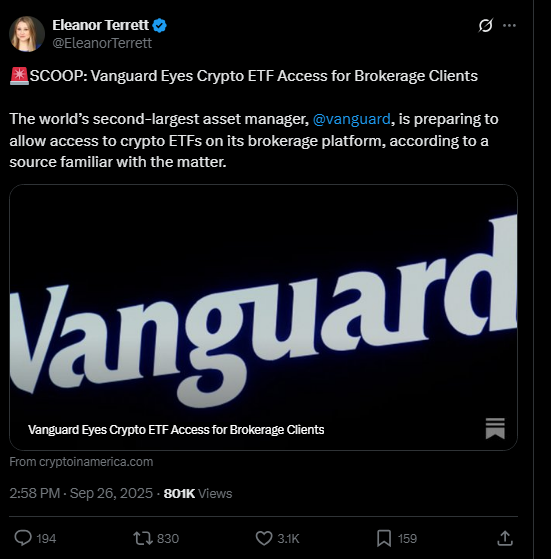Vanguard Eyes Breakthrough Crypto ETF Access for Investors
Vanguard intends to have crypto ETF accessibility to the brokerage clients, which is a shift of strategy considering the growing demand and the evolving regulatory environment.
Vanguard, the second-largest asset manager in the world, will open up cryptocurrency exchange-traded funds (ETFs) to brokerage customers.

Source –X
One of the sources cited by Eleanor Terrett on X. This is a drastic departure of the long-standing conservative approach toward digital assets by Vanguard.
The company has never been keen on crypto products and instead, they have always invested conservatively.
But growing pressure among clients and an optimistically developing regulatory landscape have led to a strategic review.
Vanguard, which introduced its own cryptocurrency ETFs, is looking at introducing a few third-party crypto ETFs to its brokerage clients, according to insiders.
Regulatory Winds are in the favor of digital assets.
Since 2024, the U.S. regulatory environment has been more accommodating of crypto, as the Securities and Exchange Commission (SEC) has authorized new listing standards to be applied to crypto ETFs.
This has enabled the entry of more crypto ETFs in the market with Bitcoin and Ethereum funds attracting large inflows.
The new CEO of Vanguard, Salim Ramji, who once assisted BlackRock in the success of its Bitcoin ETF IBIT, seems to be guiding the company in this direction with access to crypto.
Experts report that the familiarity of the CEO with crypto ETFs is probably contributing to the more open position of Vanguard .
EricBalchunas wrote on X
“Vanguard is looking to end bitcoin ETF ban (aka bend the knee lol). “The dynamics have been changing” Nice scoop by Eleanor. We heard chatter of this too. Smart of them imo. Bitcoin and Eth ETFs hugely popular and Salim (the CEO) was one of IBIT’s midwives so he knows.. “
Selective Access to Third-Party Products
Vanguard will take a deliberate strategy and may selectively choose third-party crypto ETFs, taking into consideration regulatory, compliance, and risk-management issues.
The company does not aim to develop proprietary crypto products, but it can allow its clients to access vetted crypto ETF options through the existing brokerage platform.
This tactic is a warning and an indication that it is prepared to play in crypto investments on a large scale. It puts Vanguard among the peers in the financial industry that have increased crypto offerings with booming institutional and retail client attention.
The post Vanguard Eyes Breakthrough Crypto ETF Access for Investors appeared first on Live Bitcoin News.
คุณอาจชอบเช่นกัน

Vitalik Buterin lays out new Ethereum roadmap at EDCON

Unlocking Massive Value: Curve Finance Revenue Sharing Proposal for CRV Holders
